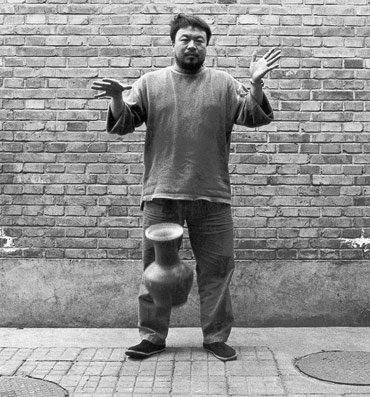photo from LA Times, April 18
If this is performance art, then it is remarkably successful. By contrast, the earlier attempt to leave China to attend Liu Xiaobo’s Nobel ceremony was met with polite, if apathetic, refusal (discussed in December, 2010 post to this blog). This trip to the airport, leading to his arrest, was a replay of that scene, but with a different result, and it was, I begin to believe, the intended result. With this arrest, Ai has opened the curtain on the stage of opinion, turned the lights on and made fully global political theatre a possibility.
The discussion of the event, though, remains to my mind largely banal. Take for instance a recent article by Lionel M. Jensen containing the following observations:
When asked about his own well-being, he expressed concern about the latest campaign against free expression. He spoke with anguish about recurring nightmares of incarceration in which tourists blankly walked around the spectacle as though it was an exhibit. “They saw everything but didn’t care…they simply acted as though this was quite normal… we live in a world of madness.”
The proximate reason for the interview was indeed an exhibit, a real one in Beijing that marked the grand reopening of the renovated Chinese National Museum on Tian’anmen Square. A high-level German delegation led by the outgoing foreign minister Guido Westerwelle was to be in Beijing on April 1 to celebrate the opening of a very prominent German exhibit, Die Kunst der Aufklärung (“Art of the Enlightenment”), with nearly six hundred objects from the State Art Collections of Berlin, Dresden, and Munich.
When asked specifically about the upcoming exhibit and its theme Ai noted the profound irony that the sanctity of individual and conscience, freedom of expression within a civil society were Enlightenment values brought, as in the transport of the exhibit itself, from the West, but that China’s own government had yet to accept them in practice. Ai had been informed that he could not appear at the opening.
Here the allegiances with civil society, with Enlightenment, in short, a kind of establishment West (even if a fantasized one), are hard to ignore. That the Chinese government should want to implement German Enlightenment values reflects the kind of cultural chauvinism that riles the tempers of far more Chinese than just those in charge of managing (and there is clearly management) China’s cultural discourse. (I wonder if Chinese exhibition organizers even were aware that the 600 or so works of art associated with the the exhibition were to be used as study objects for the transformation of Chinese society.) Regardless, the global image of an heroic, self-sacrificing cultural crusader is well underway, from the demonstrations (above), to the documentary, soon to be released.
What is strong in Ai’s performance as an artist is in his power to stimulate reflection, with often succinct and often clever maneuvers (think of Han Dynasty urns falling to their death).

What we are seeing now in global (English-language) media is anything but reflective. It is, to my mind, akin to the flipping of a switch on a stage, or perhaps even a musical cue, something mechanical, and long-before planned out by the creator of this particular theatrical event. With the auteur having departed the building, though, the question does become when (and how) the play resolves.